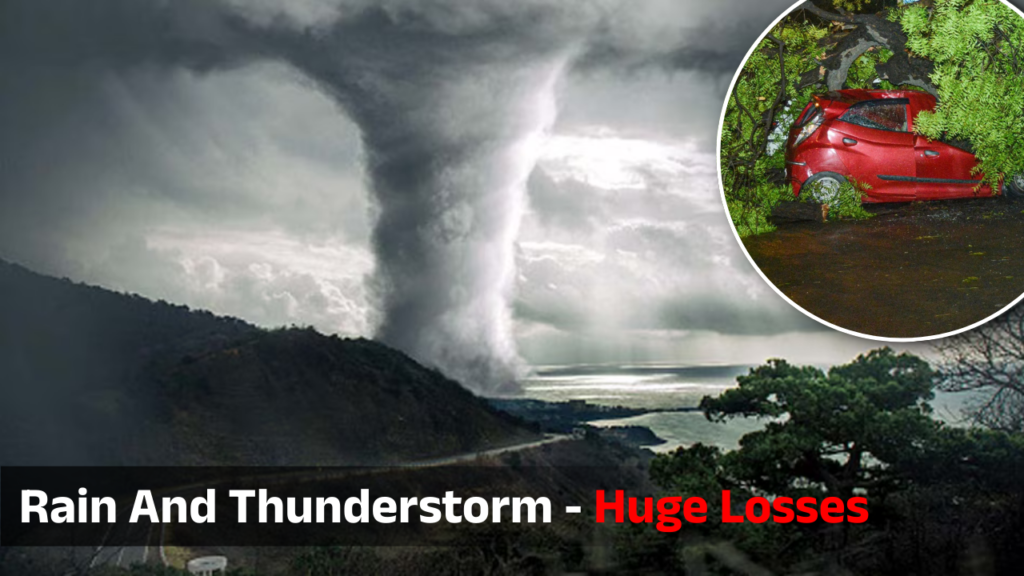A powerful thunderstorm that formed over Maharashtra on May 21, 2025, created a trail of destruction as it moved northeastward across several Indian states, finally striking Mathura in Uttar Pradesh. The storm impacted cities, villages, and farmlands along its path with strong winds, heavy rains, and dangerous lightning strikes. Here’s a full breakdown of the event, affected areas, and the current situation.
How the Storm Began: The Origin in Maharashtra
Weather System Formation
The thunderstorm originated due to a low-pressure area stretching from Tamil Nadu to the Arabian Sea, which created unstable atmospheric conditions over Maharashtra. The India Meteorological Department (IMD) had already predicted thunderstorms and issued alerts for multiple districts in the state.
Regions Initially Hit
The storm first affected several areas in central and western Maharashtra, including:
- Marathwada Region: Chhatrapati Sambhajinagar (Aurangabad), Beed, Jalna, Parbhani, Hingoli
- Madhya Maharashtra: Nashik, Pune, Jalgaon, Ahmednagar
- Vidarbha: Nagpur, Akola, Amravati, Buldhana
- Konkan Region: Mumbai, Thane, Raigad, Ratnagiri
These areas witnessed strong winds (up to 60 km/h), lightning strikes, and heavy rainfall, leading to crop damage, power outages, and waterlogging in many parts.
Mumbai and Nagpur Face Severe Impact
Mumbai Weather Trouble
In Mumbai, high winds and lightning caused injuries and property damage. According to local reports, roads were flooded and tree branches fell in many areas, leading to traffic jams and minor accidents.
Nagpur and Surrounding Cities
Cities like Nagpur and Amravati saw heavy lightning activity and sudden rainfall, which damaged farmlands and affected evening commuters. As a precaution, schools in several districts were advised to remain closed on May 22.
Storm Advances to Madhya Pradesh and Rajasthan
Central India in the Path
As the storm moved northward, it passed through parts of Madhya Pradesh and eastern Rajasthan. Cities like Indore, Ujjain, Kota, and Jaipur experienced:
- Thunderstorms with lightning
- Strong gusty winds
- Short but intense rain showers
Farmers in these regions reported damage to standing crops, especially in wheat and soybean fields.
Uttar Pradesh Hit: Mathura Bears the Brunt
Entry into Western UP
By May 22 evening, the storm reached western Uttar Pradesh, with Mathura being one of the worst-hit areas. Residents witnessed:
- Sudden blackouts
- Lightning strikes near residential zones
- Winds blowing away temporary structures
- Trees and electric poles were uprooted in some areas
Impact on Daily Life
The storm caused traffic slowdowns and flight delays at nearby airports. Emergency services were deployed, and local authorities advised people to stay indoors and avoid traveling during high winds.
List of Major Affected Areas from Start to End
Here’s a quick look at the main areas affected by the thunderstorm:
StateMajor Affected Districts/Cities
- Maharashtra Mumbai, Pune, Nagpur, Aurangabad, Beed, Nashik
- Madhya Pradesh Indore, Ujjain, Bhopal, Guna
- Rajasthan Kota, Jaipur, Bharatpur
- Uttar Pradesh Mathura, Agra, Aligarh, Hathras
IMD Warnings and Safety Advice
The India Meteorological Department (IMD) continues to monitor the system and has issued yellow alerts in some areas. People are advised to:
- Stay indoors during lightning and thunder
- Avoid standing near electric poles or trees
- Unplug electronic devices to prevent short circuits
- Check local weather apps or IMD updates regularly
Conclusion: A Wake-Up Call for Preparedness
This thunderstorm system, spanning from Maharashtra to Uttar Pradesh, highlights the growing intensity of weather events in India. With strong winds, lightning, and heavy rainfall disrupting four major states, it’s clear that better awareness and quick action are crucial.
As climate conditions continue to shift, such storms might become more frequent. Residents and authorities alike must remain alert and prepared to minimize damage and ensure safety in the future.



















